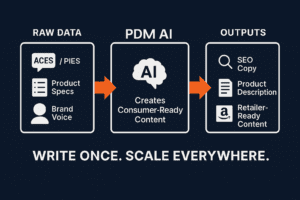Thanks to seemingly thousands of products vying for the consumer’s attention, achieving meteoric brand growth in the automotive aftermarket space is challenging.
Unlike the old days, creating a winning product is no longer enough to capture market share. Today, successful brands must deploy the right combination of product content management, marketing, and products that deliver on promises of performance or quality. Despite the challenges, dozens of resources and tools are available to help automotive aftermarket brands refine their content management strategy to achieve success.
This post outlines five content management strategies to enhance your brand’s visibility and drive progress.
Accuracy: Updated Product Content
Maintaining accurate, and compelling product listings is instrumental to eCommerce success. Not only does the listing have to convey the image and energy of the product/brand, but it also needs to deliver crucial information about fitment and specifications.
Aftermarket companies have the unique challenge of having one product line that fits dozens or even hundreds of different vehicles, across multiple years of production. As a result, incorrect product information can result in a customer getting the wrong product entirely or not meeting expectations. Fitment tools are meant to help ensure this doesn’t happen, but if the source data needs to be corrected, the tool’s effectiveness is diminished completely.
ACES and PIES data create a universal standard for aftermarket companies to follow when listing a product for sale. The best aftermarket product companies use leading PIM (Product Information Management) systems to manage the ACES and PIES data and ensure that it lines up with products offered for sale across multiple eCommerce platforms. PIM systems automate the process and prevent data management issues that can plague a product line.
Moreover, PIM systems streamline the process of updating product information across various platforms. With systems such as PDM Automotive, instead of manually editing each eCommerce listing, users can update the information at its source. This update then automatically propagates to all linked eCommerce partners simultaneously.
This ensures that when a customer visits an eCommerce website, they can trust that the product they need for their car is accurately listed and available for purchase. A PIM system guarantees this level of reliability.
Compelling & SEO-friendly Product Descriptions
The automotive aftermarket industry thrives on passion, a sentiment that must be clearly communicated to customers as soon as they view an online listing.
Persuading a customer to make a purchase involves several steps. Initially, customers must verify that the product is the correct fit and meets their requirements. Then, amidst a vast selection of parts, making the right choice becomes the critical point where sales are either secured or missed.
Compelling product descriptions need to explain the basics of a part and to emote how the product meets the customer’s goals. For example, a cat-back exhaust system not only helps an enthusiast buyer stand out but can also bring an additional measure of performance and responsiveness. Benefits such as quality, materials, and warranties all come to mind as potential reasons a customer may purchase a particular product for their vehicle.
In addition to a compelling product story, listings need to be SEO-friendly so they can be properly indexed on search engines. Many tools, such as PDM Automotive’s award-winning AI-powered content generation tool, help product and marketing managers create listings that are both attractive to consumers and SEO-optimized. However, it is important to craft engaging product descriptions without packing in so many keywords that the product description loses meaning.
Scalable Distribution of Content Across Channels
Aftermarket product manufacturers may want to get their product to every conceivable eCommerce platform and in front of every possible consumer, but achieving large-scale rollouts with the right tools is a challenging task.
PIM systems can be instrumental in achieving success in large-scale rollouts, whether you’re establishing a new business or expanding your product offerings. After preparing ACES and PIES data, a well-configured PIM system communicates with multiple eCommerce platforms through APIs. This means catalog managers only need to update product content in one place. The PIM system then distributes this data in the correct format across different platforms, simplifying the management process and ensuring consistency.
As companies grow, PIM systems make it easy to add new product lines quickly, meaning that consumers can get their hands on the latest products and companies can enjoy the immediate benefits of visibility across multiple channels. No matter how large a company grows, this scalable strategy will continue to form the backbone of its success.
Sharing Up-to-Date Data To Retailers In The Format They Need
When selling to eCommerce retailers, translating product information into established data standards like ACES and PIES is only part of the story.
Marketplaces like Amazon or Walmart require aftermarket companies to submit accurate product data that meets ACES and PIES standards. They also require manufacturers to upload this data to their unique internal systems. This requirement creates another level of complexity for companies who want to sell their products on established platforms. The constant updates to these systems and the need for specific file types or formats significantly increase the challenge and workload for catalog managers responsible for managing product information.
PIM systems like PDM Automotive can remove complexity by directly interacting with eCommerce systems via advanced APIs. Instead of training a person to use every unique eCommerce system, PIM systems do the work for them, allowing companies to focus on the source data as the single source of truth.
As frustrating as it can be to utilize multiple systems, a PIM system removes this frustration and makes it easy to sell on the markets’ best platforms.
Aligning Content Management with Marketing & Brand Strategies
Successful aftermarket companies thrive on seamless collaboration across departments.
For instance, the marketing strategy should be clearly reflected in all aspects of a new product launch. This could be as straightforward as incorporating the brand’s logo in images or as intricate as weaving the brand’s core values into the product descriptions. The tone and energy used in these elements can significantly influence customer engagement, either driving more sales or potentially deterring customers from the brand.
When a product lands in the hands of consumers, they need to feel like they are part of that brand’s story. Intrinsic benefits like a rich racing heritage, a history of innovation, or parts made in America are all things that can be conveyed from the top of the marketing pyramid right down to the product that lands on a car enthusiast’s doorstep.
Achieving this fluidity is no easy task, but it’s absolutely within reach with some guidance and the right PIM system and internal alignment.
PDM Automotive Helps Enhance Brand Visibility
Effective content management is crucial to the success story of the world’s best automotive aftermarket brands.
To help make content management as easy as possible, PIM Automotive is proud to offer a suite of products and services designed for companies in the automotive aftermarket space. Our advanced PIM (Product Information Management) systems provide an easy and effective way for brands to bring their winning products to market across all the best eCommerce platforms. From product descriptions to ACES and PIES data, PDM Automotive helps aftermarket companies manage their products effectively.
In addition to data management, PDM Automotive offers a crucial look into the sales data for multiple products in one location. This visibility allows companies to make data-driven decisions that can move the needle on products that are not performing well by exposing potential blindspots in a catalog of products.



